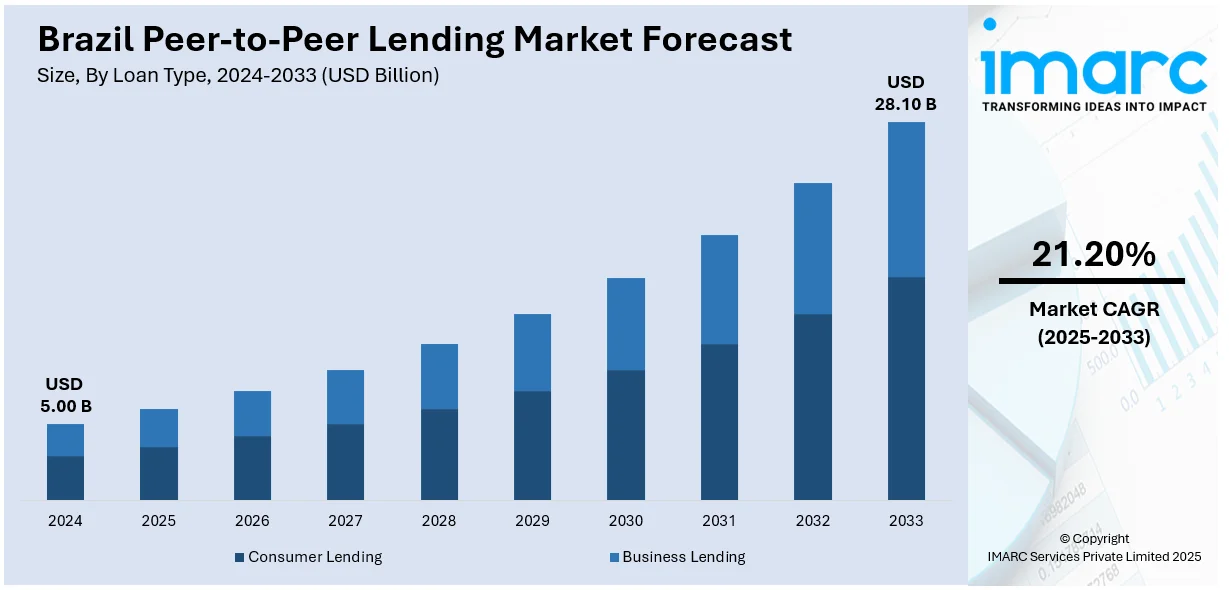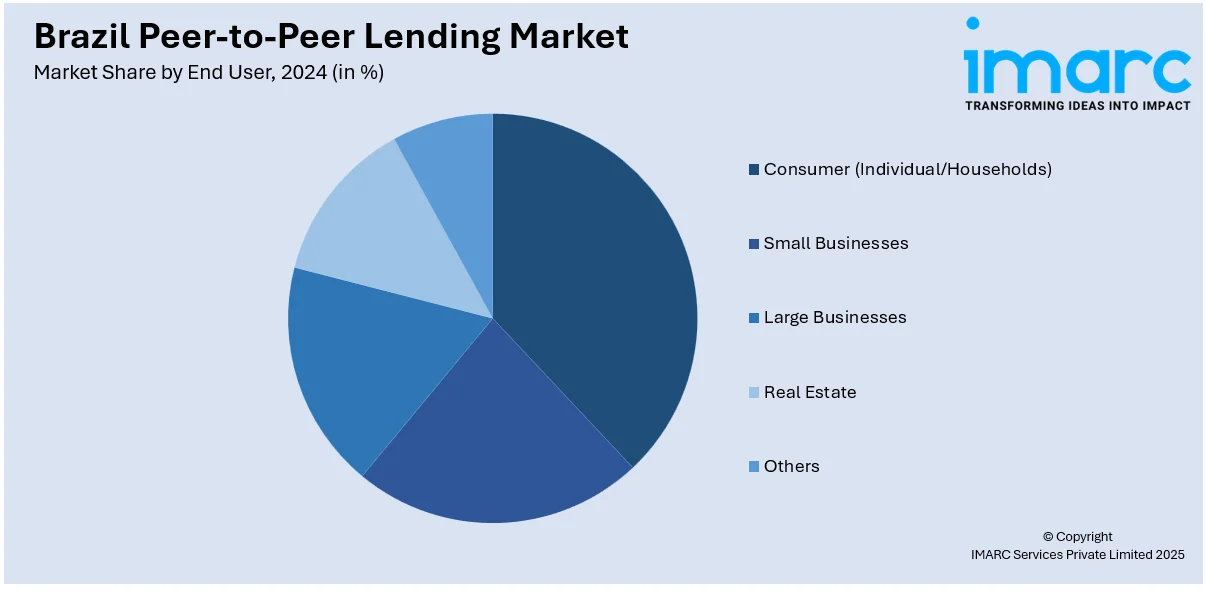
Brazil Peer-to-Peer Lending Market Size, Share, Trends and Forecast by Loan Type, Business Model, End User, and Region, 2025-2033
Brazil Peer-to-Peer Lending Market Overview:
The Brazil peer-to-peer lending market size reached USD 5.00 Billion in 2024. Looking forward, IMARC Group expects the market to reach USD 28.10 Billion by 2033, exhibiting a growth rate (CAGR) of 21.20% during 2025-2033. The market is primarily driven by the increased adoption of digital platforms, considerable rise in the demand for alternative financing options, and enhanced regulatory oversight aimed at enhancing transparency and risk management among borrowers and investors.
|
Report Attribute
|
Key Statistics
|
|---|---|
|
Base Year
|
2024
|
|
Forecast Years
|
2025-2033
|
|
Historical Years
|
2019-2024
|
| Market Size in 2024 | USD 5.00 Billion |
| Market Forecast in 2033 | USD 28.10 Billion |
| Market Growth Rate (2025-2033) | 21.20% |
Brazil Peer-to-Peer Lending Market Trends:
Growing Adoption of Digital Platforms
In Brazil, the P2P lending market is experiencing a significant change with the high usage of digital platforms. As high internet penetration and mass usage of cell phones have occurred, both borrowers and lenders are making extensive use of online platforms to facilitate quicker and more convenient transactions. For instance, as per industry reports, in 2024, Brazil reported 187.9 Million internet users, with an internet penetration rate of 86.6%. These digital tools streamline the lending process, enhance transparency and trust between lenders and borrowers as well as offer a more convenient alternative to traditional banking services. As fintech innovations become more accessible, particularly in underserved regions, P2P lending platforms are providing greater access to credit for individuals and small businesses that were previously excluded from the financial system. This trend is impelling the P2P market growth as technology continues to lower the barriers to entry, making lending easier, faster, and more inclusive for a wider audience.

Increased Regulatory Oversight
Brazilian regulators are intensifying their efforts to ensure adequate oversight and risk management of the expanding peer-to-peer lending industry. Initially, the sector operated with minimal regulation, but growing concerns over consumer protection, data security, and fraud have prompted a more structured regulatory approach. For instance, in July 2024, the Brazilian National Monetary Council (CMN) issued Resolution No. 5,159 to expand credit fintech business models. Through this regulation Direct Credit Companies (SCDs) and Peer-to-Peer Loan Companies (SEPs) gain new lending capabilities, reducing costs, improving financial inclusion, and increasing credit access for small and medium-sized businesses. Additionally, the new rules seek to regulate openness, create user protections, and provide clearer criteria for borrower-lender interactions. As a result of these modifications, P2P platforms should now be held to higher operational and financial standards, increasing their legitimacy. While more regulation might render P2P platforms more expensive to operate and compel them to change their business plans, it's also anticipated to improve consumer confidence and encourage additional market expansion as trust in the system strengthens.
Brazil Peer-to-Peer Lending Market Segmentation:
IMARC Group provides an analysis of the key trends in each segment of the market, along with forecasts at the country level for 2025-2033. Our report has categorized the market based on loan type, business model and end user.
Loan Type Insights:
- Consumer Lending
- Business Lending
The report has provided a detailed breakup and analysis of the market based on the loan type. This includes consumer lending and business lending.
Business Model Insights:
- Marketplace Lending
- Traditional Lending
A detailed breakup and analysis of the market based on the business model have also been provided in the report. This includes marketplace lending and traditional lending.
End User Insights:

- Consumer (Individual/Households)
- Small Businesses
- Large Businesses
- Real Estate
- Others
The report has provided a detailed breakup and analysis of the market based on the end user. This includes consumer (individual/households), small businesses, large businesses, real estate, and others.
Regional Insights:
- Southeast
- South
- Northeast
- North
- Central-West
The report has also provided a comprehensive analysis of all the major regional markets, which include Southeast, South, Northeast, North, and Central-West.
Competitive Landscape:
The market research report has also provided a comprehensive analysis of the competitive landscape. Competitive analysis such as market structure, key player positioning, top winning strategies, competitive dashboard, and company evaluation quadrant has been covered in the report. Also, detailed profiles of all major companies have been provided.
Brazil Peer-to-Peer Lending Market News:
- In January 2023: PicPay, a major digital wallet in Brazil, launched a peer-to-peer lending service for companies, making it one of the first fintechs in the country to do so. This new feature allows users to lend money to companies through the app, with a maximum return of 20% per year. The company aims to provide a faster, less bureaucratic, and tax-free way for companies to obtain resources. Initially limited to entities within the J&F Group, PicPay intends to expand its services to include various sectors soon. The credit market in Brazil is highly lucrative, with interest rates reaching triple digits, making this new lending service attractive for both companies and investors.
- In March 2023: Brazil’s central bank approved Meta Platforms' launch of a payment system for small and medium-sized businesses on WhatsApp. This expands on the existing peer-to-peer payment feature, allowing merchants to receive payments. Users will soon be able to pay for products and services directly within WhatsApp using Mastercard and Visa debit/credit cards.
Brazil Peer-to-Peer Lending Market Report Coverage:
| Report Features | Details |
|---|---|
| Base Year of the Analysis | 2024 |
| Historical Period | 2019-2024 |
| Forecast Period | 2025-2033 |
| Units | Billion USD |
| Scope of the Report |
Exploration of Historical Trends and Market Outlook, Industry Catalysts and Challenges, Segment-Wise Historical and Future Market Assessment:
|
| Loan Types Covered | Consumer Lending, Business Lending |
| Business Models Covered | Marketplace Lending, Traditional Lending |
| End Users Covered | Consumer (Individual/Households), Small Businesses, Large Businesses, Real Estate, Others |
| Regions Covered | Southeast, South, Northeast, North, Central-West |
| Customization Scope | 10% Free Customization |
| Post-Sale Analyst Support | 10-12 Weeks |
| Delivery Format | PDF and Excel through Email (We can also provide the editable version of the report in PPT/Word format on special request) |
Key Questions Answered in This Report:
- How has the Brazil peer-to-peer lending market performed so far and how will it perform in the coming years?
- What is the breakup of the Brazil peer-to-peer lending market on the basis of loan type?
- What is the breakup of the Brazil peer-to-peer lending market on the basis of business model?
- What is the breakup of the Brazil peer-to-peer lending market on the basis of end user?
- What is the breakup of the Brazil peer-to-peer lending market on the basis of region?
- What are the various stages in the value chain of the Brazil peer-to-peer lending market?
- What are the key driving factors and challenges in the Brazil peer-to-peer lending market?
- What is the structure of the Brazil peer-to-peer lending market and who are the key players?
- What is the degree of competition in the Brazil peer-to-peer lending market?
Key Benefits for Stakeholders:
- IMARC’s industry report offers a comprehensive quantitative analysis of various market segments, historical and current market trends, market forecasts, and dynamics of the Brazil peer-to-peer lending market from 2019-2033.
- The research report provides the latest information on the market drivers, challenges, and opportunities in the Brazil peer-to-peer lending market.
- Porter's five forces analysis assist stakeholders in assessing the impact of new entrants, competitive rivalry, supplier power, buyer power, and the threat of substitution. It helps stakeholders to analyze the level of competition within the Brazil peer-to-peer lending industry and its attractiveness.
- Competitive landscape allows stakeholders to understand their competitive environment and provides an insight into the current positions of key players in the market.
Need more help?
- Speak to our experienced analysts for insights on the current market scenarios.
- Include additional segments and countries to customize the report as per your requirement.
- Gain an unparalleled competitive advantage in your domain by understanding how to utilize the report and positively impacting your operations and revenue.
- For further assistance, please connect with our analysts.
 Inquire Before Buying
Inquire Before Buying
 Speak to an Analyst
Speak to an Analyst
 Request Brochure
Request Brochure
 Request Customization
Request Customization




.webp)




.webp)












